Many aquarium/52-marine-animals.html">marine animals have amazing camouflage abilities that allow them to blend into their surroundings.
Camouflage helps animals protect themselves from predators by blending into their surroundings so that predators can swim by without seeing them.
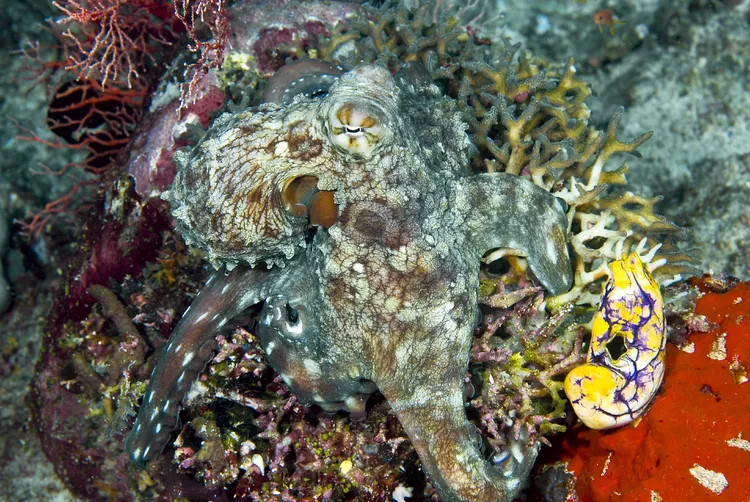
Close-up of an octopus on coral
Camouflage also helps animals sneak up on prey. A shark, ray, or octopus may be lurking on the ocean floor, waiting to prey on an unsuspecting fish that passes by.
Below, take a look at some amazing examples of marine camouflage and learn about animals that are able to blend in perfectly with their surroundings.
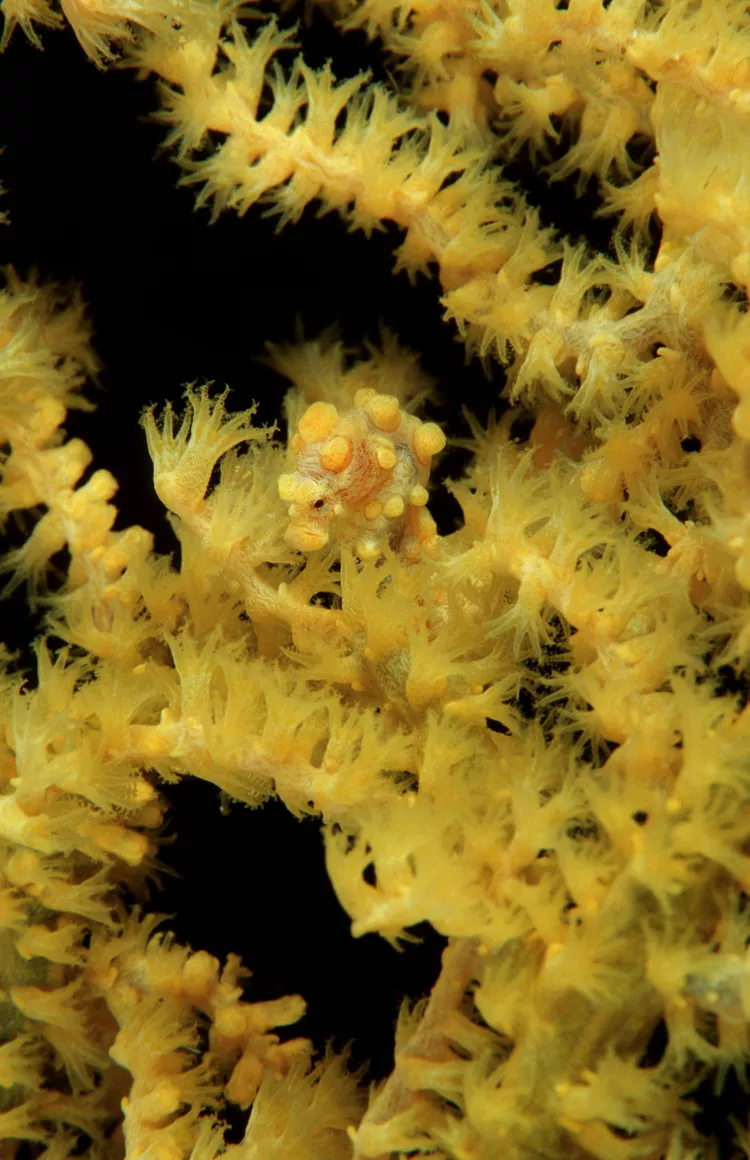
Yellow pygmy seahorse (Hippocampus bargibanti) on a sea fan in Komodo Island, Indonesia
Seahorses change color and shape depending on their preferred habitat. And many don’t swim very far in a day. Although they are fish, they are not good swimmers and may rest in the same place for several days.
Pygmy seahorses are tiny seahorses that are less than 3 centimeters long. There are about nine different species of pygmy seahorses.
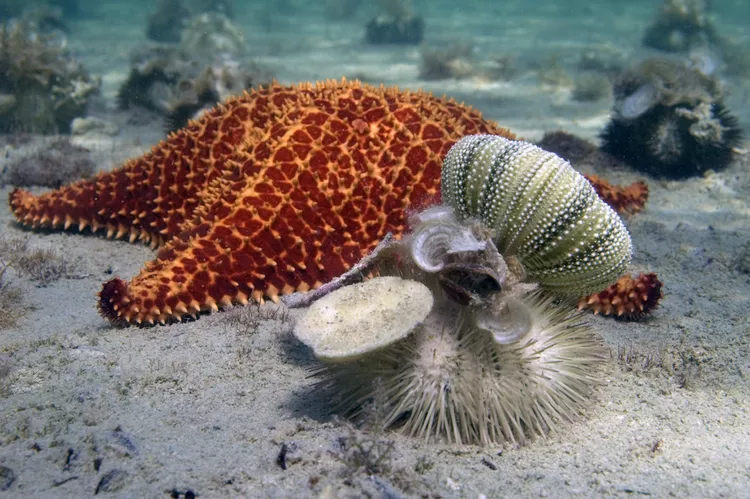
A sea urchin holds camouflage, including the skeleton of another sea urchin, with a cushion starfish in the background, in Curacao, Netherlands Antilles.
Some animals, like sea urchins, don’t change color to blend in with their surroundings, but instead pick up objects to hide themselves. This sea urchin is carrying all sorts of stuff, including the skeleton of another sea urchin (test)! A passing predator might think the urchin is just part of the rocks and rubble on the seafloor.

A wobbegong shark camouflages itself in its habitat in Raja Ampat, Papua New Guinea, Indonesia.
With its mottled coloration and dermal lobes extending from its head, wobbegong sharks can easily blend in with the seafloor. These sharks, which are about 1.2 meters long, feed on bottom-dwelling invertebrates and fish. They live in relatively shallow coral reefs and caves in the western Pacific Ocean.
The wobbegong shark patiently waits on the seafloor. When prey swims by, it leaps up and grabs it before the shark even gets close. The shark’s mouth is so large that it can even swallow other sharks. This shark has very sharp, needle-like teeth that it uses to grab prey.
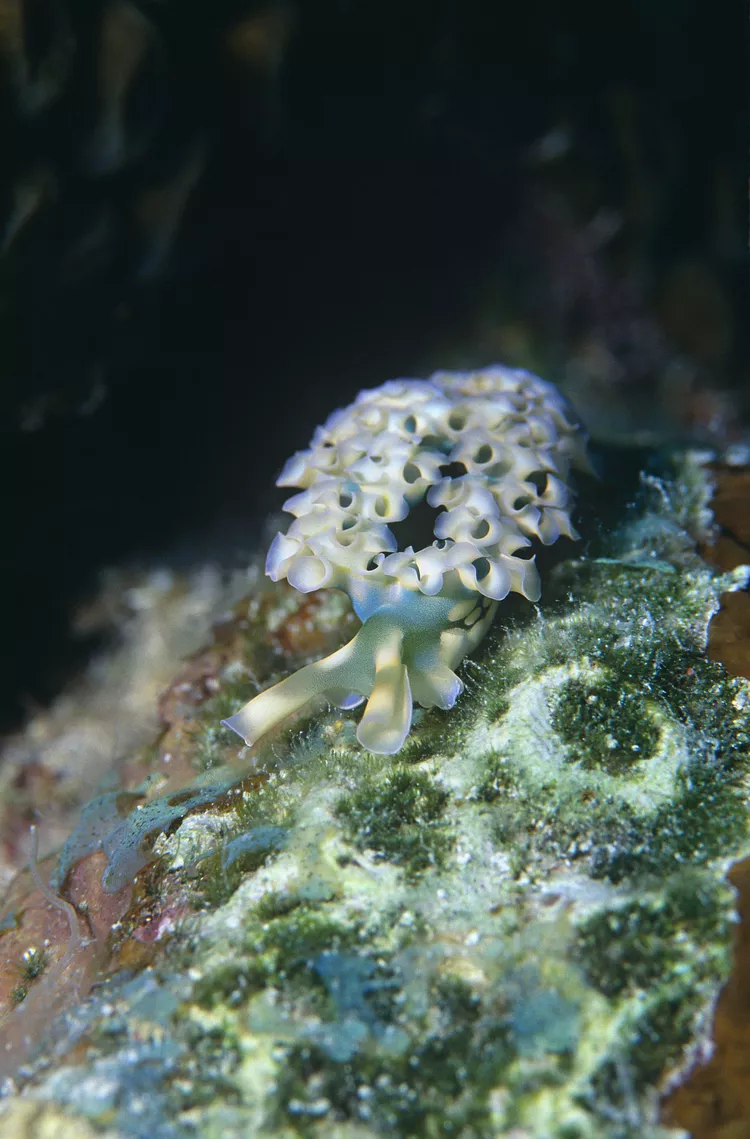
Lettuce Leaf Nudibranch
This nudibranch can grow up to 6 cm long and 2 cm wide. It lives in the warm waters of the Caribbean Sea.
This is a sea slug that uses the sun's energy - like plants, it has chloroplasts that photosynthesize, giving it a green color. The sugars produced in the process provide nutrition for the nudibranch.

King Shrimp (Periclimenes imperator) mating with Spanish Dancer Nudibranch (Hexabranchus sanguineus) in Indonesia.
The color of this king shrimp allows it to blend in perfectly with the body of a Spanish dancer nudibranch. This shrimp is also known as a cleaner shrimp because it feeds on algae, plankton and parasites from its nudibranch and sea cucumber hosts.
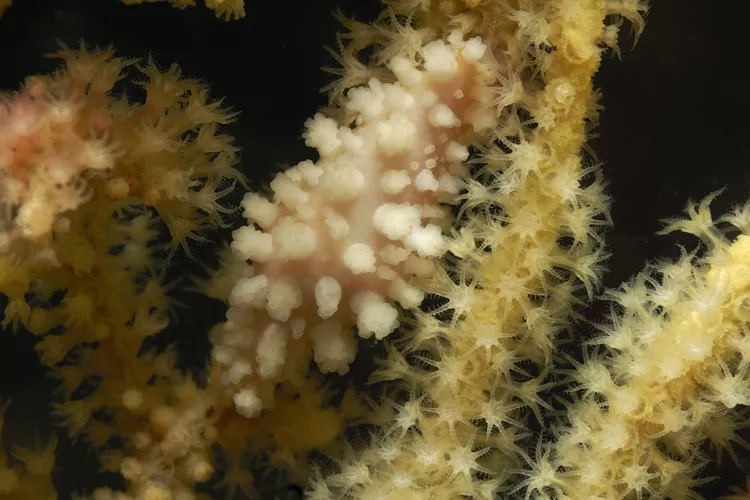
This nudibranch blends in perfectly with the polyps of the coral it inhabits.
Nudibranchs are also known as egg-throwing snails. Their shells are basil-like, but covered in the mantle of a snail. This snail feeds on corals and sea fans and hides from predators by cleverly blending in with its surroundings (taking on the color of its prey). What could be better than hiding from predators and getting a meal at the same time?
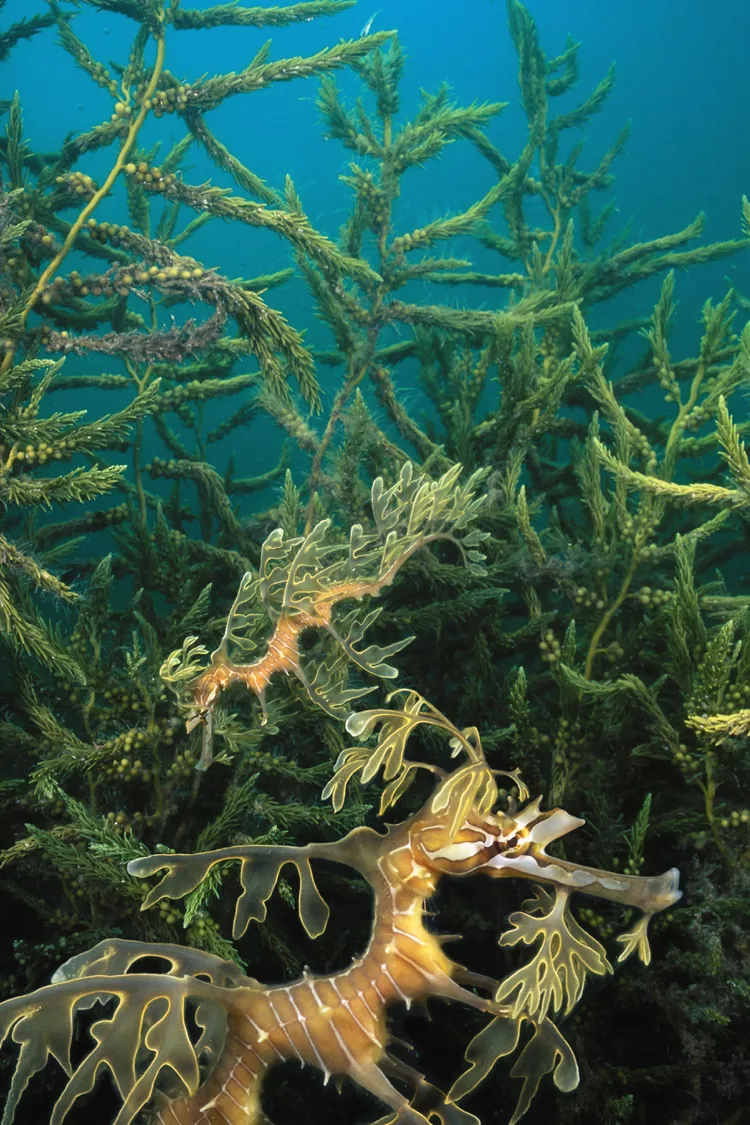
Leafy sea dragons are among the most spectacular looking fish. These relatives of the seahorse have long, flowing appendages and a yellow, green, or brown body coloration that allows them to blend in well with kelp and other seaweed in their shallow water habitats.
Leafy sea dragons can grow up to about 12 inches (about 30 centimeters) in length. They feed on small crustaceans, sucking them up with their straw-like snouts.
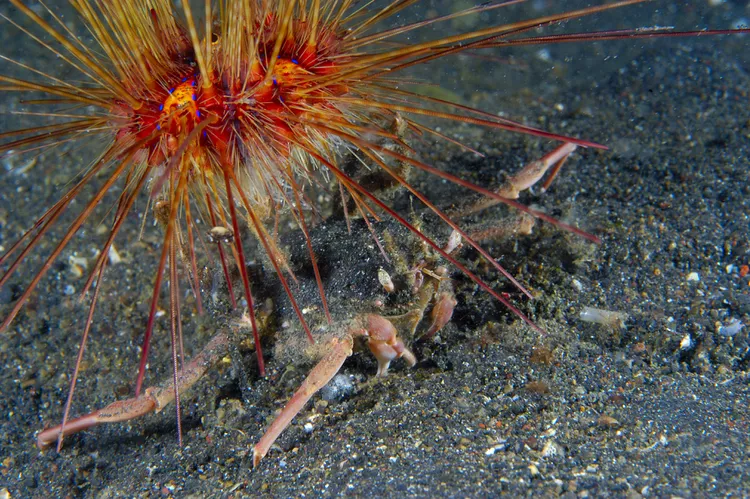
A sea urchin crab camouflages itself by carrying a sea urchin on its back in the Lembeh Straits of Sulawesi and Celebes, Indonesia.
The sea urchin crab has a symbiotic relationship with several species of sea urchins. The crab uses its hind legs to carry the sea urchin on its back to hide itself. The urchin's spines also help protect the sea urchin crab. In turn, the urchins benefit by being carried to where food is more plentiful.
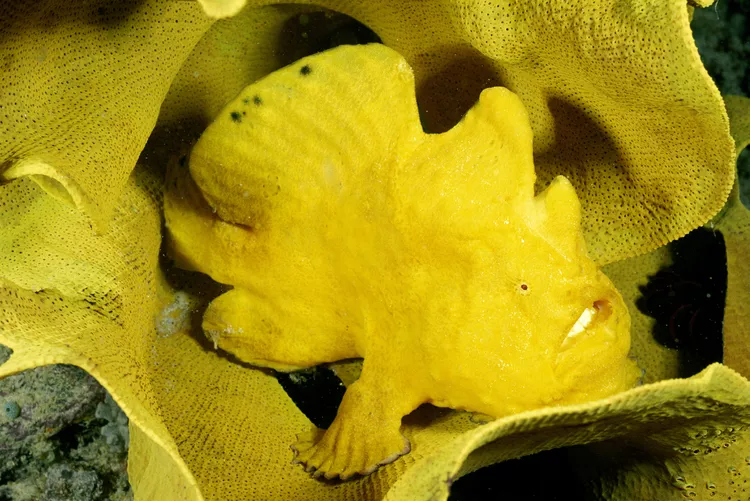
A giant frogfish camouflaged in a yellow sponge on Mabul Island, Malaysia.
They're bulky and scaleless, but they're masters of disguise. Who are they? Giant frogfish!
They don't look like bony fish, but they do have a bony skeleton, like some of the more familiar fish we know, like cod, tuna, and haddock. They're rounded in shape, and sometimes use their pectoral fins to walk on the seafloor.
Giant frogfish may camouflage themselves in sponges or on the seafloor. These fish can change their color and even texture to help them blend in. Why do they do this? To trick their prey. A giant frogfish's mouth can open up to 12 times its own size, so they can swallow prey in one gulp. If the stealth strategy fails, frogfish have a second option - like anglerfish, they have an evolved spine that acts as a fleshy "bait" to attract prey. When curious animals, such as small fish, approach, the frogfish swallows them whole.

Common cuttlefish on the seafloor of Istria in the Adriatic Sea, Croatia.
Cuttlefish have impressive intelligence and camouflage abilities, but for a short-lived animal with a lifespan of only 1-2 years, these abilities are mostly wasted.
The muscles of the squid's skin are attached to millions of pigment cells (chromatophores). When the squid contracts its muscles, the pigment is released into the skin, changing the squid's color and even pattern.

A pygmy seahorse camouflaged on a soft coral.
The color, shape, and size of Bart's Pygmy Seahorse allow it to blend in with its surroundings.
Bart's Seahorse lives on soft corals called gorgonians, which it holds onto with its tufted tail. It is believed to feed on tiny organisms such as crustaceans and zooplankton.
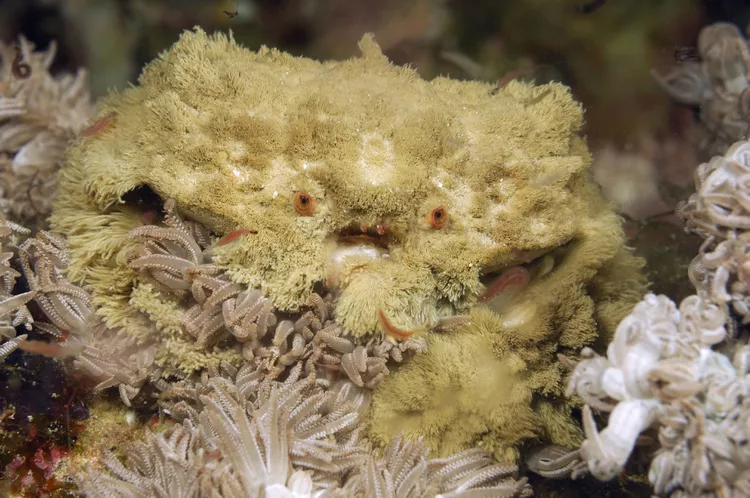
Decorator Crab (Dromia dormia), Komodo Island, Indonesia.
The Decorator Crab shown here looks a bit like an underwater Chewbacca.
Decorator Crabs use organisms such as sponges (shown here), bryozoans, anemones, and algae for camouflage. They have bristles on the back of their carapace that they use to cling to these creatures.
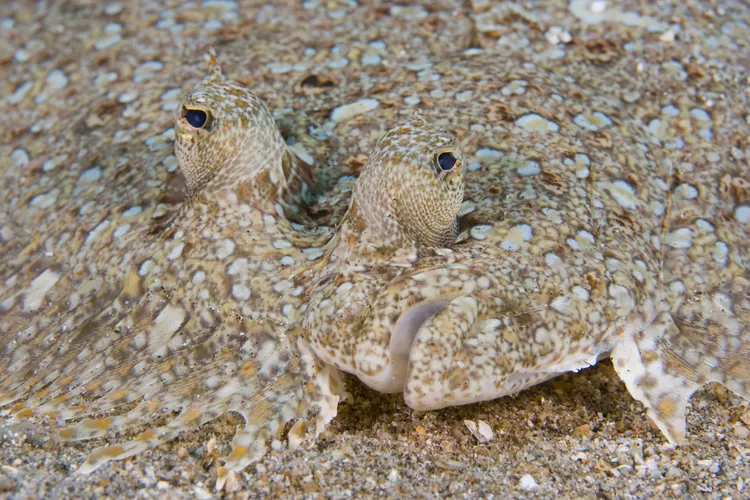
The peacock flounder (Bothus mancus) camouflages itself on the seafloor.
The fish shown here is the spotted flounder, also known as the peacock flounder. The flounders lie flat on the seafloor with their eyes on one side, which makes them look very strange. What makes them even more interesting is that they have the ability to change color.
Peacock flounders have beautiful blue spots on their bodies. They can "walk" on the seafloor with their fins, changing color as they move. They can even create a checkerboard pattern. This remarkable color-changing ability comes from pigment cells called chromatophores.
This species is found in tropical waters of the Indo-Pacific and Eastern Pacific Oceans, living on sandy seafloors in shallow waters.

A Devil Scorpion Fish with a butterfly fish in its mouth in Hawaii.
Devil Scorpion Fish are ambush predators with a powerful bite. They lurk on the seafloor, waiting for small fish and invertebrates to take the bait. When food comes close, the scorpion fish leaps up and swallows the prey whole.
These fish also have poisonous spines on their backs that help protect them from predators. They can also sting humans, causing pain.
In this image, you can see that the scorpion fish blends in with the seafloor and contrasts with the bright butterfly fish that is its prey.
animal tags: Marine Animal Camouflage
We created this article in conjunction with AI technology, then made sure it was fact-checked and edited by a Animals Top editor.